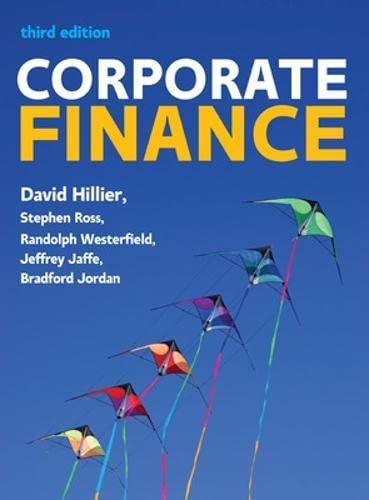Kartner Meister was recently hired by S&S Air AB to assist the company with its short-term financial
Question:
Kartner Meister was recently hired by S&S Air AB to assist the company with its short-term financial planning and to evaluate the company’s performance. Kartner graduated from university 5 years ago with a finance degree. He has been employed in the finance department of a major German company since then.
S&S Air was founded 10 years ago by two friends, Stephan Lochner and Hans Multscher.
The company has manufactured and sold light airplanes over this period, and the company’s products have received high reviews for safety and reliability. The company has a niche market in that it sells primarily to individuals who own and fly their own airplanes. The company has two models: the Birdie, which sells for €53,000, and the Eagle, which sells for €78,000.
S&S Air is not publicly traded, but the company needs new funds for investment opportunities. In consultation with Conrad Witz of underwriter Koerbecke and Pleydenwurff, Kartner decided that a convertible bond issue with a 20-year maturity is the way to go. He met with the owners, Stephan and Hans, and presented his analysis of the convertible bond issue.
Because the company is not publicly traded, Kartner looked at comparable publicly traded companies and determined that the average PE ratio for the industry is 12.5. Earnings per share for the company are €1.60. With this in mind, Kartner concluded that the conversion price should be €25 per share.
Several days later Stephan, Hans and Kartner met again to discuss the potential bond issue.
Both Hans and Stephan have researched convertible bonds and have questions for Kartner.
Hans begins by asking Kartner if the convertible bond issue will have a lower coupon rate than a comparable bond without a conversion feature. Kartner replies that to sell the bond at par value, the convertible bond issue would require a 6 per cent coupon rate with a conversion value of €800, while a plain vanilla bond would have a 7 per cent coupon rate.
Hans nods in agreement, and he explains that the convertible bonds are a win–win form of financing. He states that if the value of the company equity does not rise above the conversion price, the company has issued debt at a cost below the market rate (6 per cent instead of 7 per cent). If the company’s equity does rise to the conversion value, the company has effectively issued shares at above the current value.
Stephan immediately disagrees, arguing that convertible bonds are a no-win form of financing. He argues that if the value of the company equity rises to €25, the company is forced to sell shares at the conversion price. This means the new shareholders (those who bought the convertible bonds) benefit from a bargain price. Put another way, if the company prospers, it would have been better to have issued straight debt so that the gains would not be shared.
Kartner has gone back to Conrad for help. As Conrad’s assistant, you have been asked to prepare another memo answering the following questions:
1 Why do you think Kartner is suggesting a conversion price of €25? Given that the company is not publicly traded, does it even make sense to talk about a conversion price?
2 What is the floor value of the S&S Air convertible bond?
3 What is the conversion ratio of the bond?
4 What is the conversion premium of the bond?
5 What is the value of the option?
6 Is there anything wrong with Hans’ argument that it is cheaper to issue a bond with a convertible feature because the required coupon is lower?
7 Is there anything wrong with Stephan’s argument that a convertible bond is a bad idea because it allows new shareholders to participate in gains made by the company?
8 How can you reconcile the arguments made by Hans and Stephan?
9 During the debate, a question comes up concerning whether the bonds should have an ordinary (not make-whole) call feature. Kartner confuses everybody by stating, ‘The call feature lets S&S Air force conversion, thereby minimizing the problem Stephan has identified.’ What is he talking about? Is he making sense?
Step by Step Answer:

Corporate Finance
ISBN: 9780077173630
3rd Edition
Authors: David Hillier, Stephen A. Ross, Randolph W. Westerfield, Bradford D. Jordan, Jeffrey F. Jaffe





